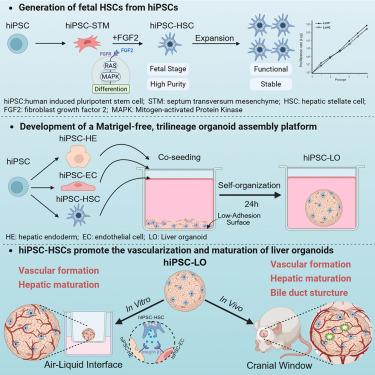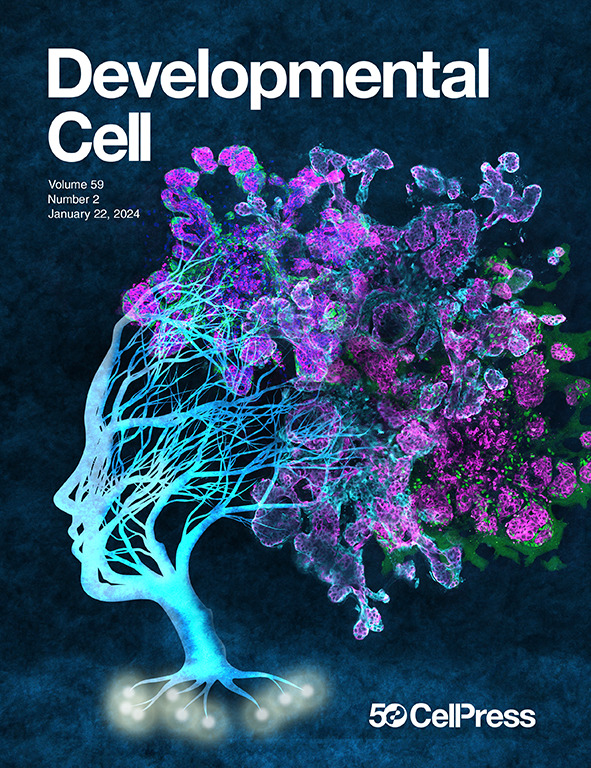人多能干细胞衍生的胎儿肝星状细胞促进肝类器官的血管化和成熟
IF 8.7
1区 生物学
Q1 CELL BIOLOGY
引用次数: 0
摘要
人类诱导多能干细胞(hiPSC)衍生的肝类器官(LOs)对于研究人类肝脏器官发生具有重要价值,但由于缺乏特定的细胞成分,在忠实再现某些过程(如血管发生)方面面临挑战。肝星状细胞(HSCs)是肝脏特异性周细胞,可能对肝脏血管形成至关重要,但由于其疾病相关状态和低效的生成过程,在发育研究中仍未得到充分利用。在这里,我们提出了一种高效的方法来生成hipsc衍生的造血干细胞(hipsc - hsc),类似于胎儿人造血干细胞的转录组谱。这些hipsc - hsc在保持基本细胞特征的同时表现出卓越的可扩展性(105倍)。此外,在由造血干细胞、肝内胚层和内皮细胞组成的完全由hipsc衍生的LO中,hipsc - hsc在LO成熟和血管化中起着至关重要的作用,无论是在体外还是在体内。这项工作在理解HSC在人类肝脏发育中的作用方面取得了重大进展,并且含有hipsc -HSC的LOs在模拟先天性人类肝脏疾病方面具有潜力。本文章由计算机程序翻译,如有差异,请以英文原文为准。

Human pluripotent stem cell-derived fetal hepatic stellate cells promote vascularization and maturation in liver organoids
Human-induced pluripotent stem cell (hiPSC)-derived liver organoids (LOs) are valuable for studying human liver organogenesis but face challenges in faithfully recapitulating certain processes, like vasculogenesis, due to the lack of specific cell components. Hepatic stellate cells (HSCs), which are liver-specific pericytes and might be crucial for liver vasculogenesis, remain underutilized in developmental studies because of their disease-related status and inefficient generation process. Here, we present an efficient method for generating hiPSC-derived HSCs (hiPSC-HSCs) resembling the transcriptomic profiles of fetal human HSCs. These hiPSC-HSCs exhibit exceptional expandability (>105-fold) while maintaining essential cellular features. Additionally, in entirely hiPSC-derived LOs consisting of HSCs, hepatic endoderm, and endothelial cells, hiPSC-HSCs play a vital role in LO maturation and vascularization, both in vitro and in vivo. This work represents a significant advancement in understanding HSC roles in human liver development, and LOs containing hiPSC-HSCs hold potential in modeling congenital human liver diseases.
求助全文
通过发布文献求助,成功后即可免费获取论文全文。
去求助
来源期刊

Developmental cell
生物-发育生物学
CiteScore
18.90
自引率
1.70%
发文量
203
审稿时长
3-6 weeks
期刊介绍:
Developmental Cell, established in 2001, is a comprehensive journal that explores a wide range of topics in cell and developmental biology. Our publication encompasses work across various disciplines within biology, with a particular emphasis on investigating the intersections between cell biology, developmental biology, and other related fields. Our primary objective is to present research conducted through a cell biological perspective, addressing the essential mechanisms governing cell function, cellular interactions, and responses to the environment. Moreover, we focus on understanding the collective behavior of cells, culminating in the formation of tissues, organs, and whole organisms, while also investigating the consequences of any malfunctions in these intricate processes.
 求助内容:
求助内容: 应助结果提醒方式:
应助结果提醒方式:


